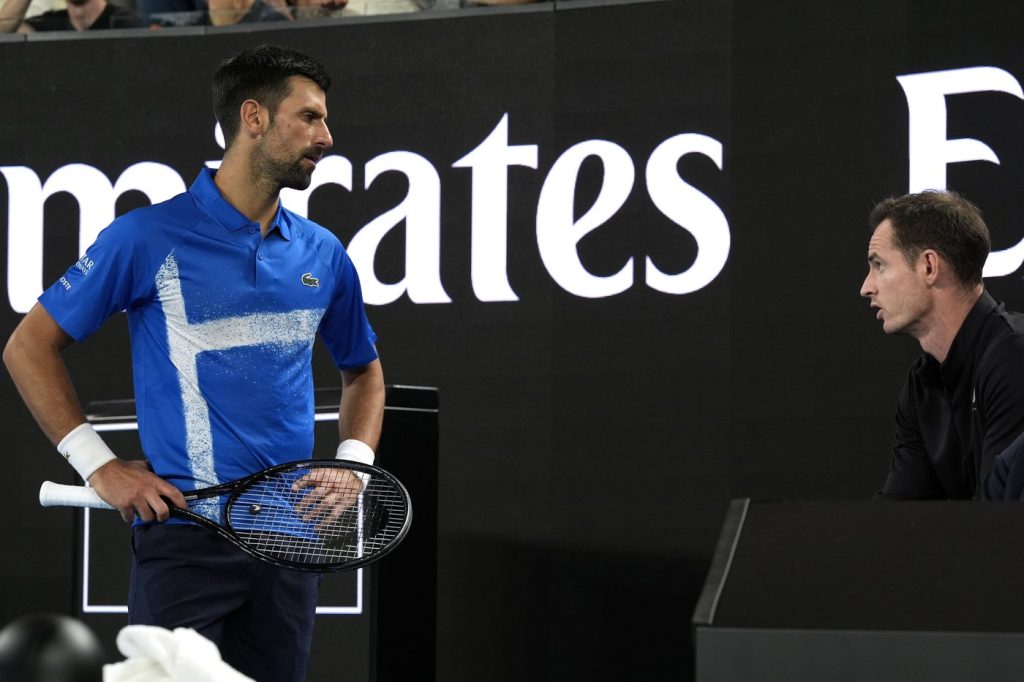MELBOURNE, Australia (AP) In a groundbreaking moment at the 2025 Australian Open, Novak Djokovic engaged in a face-to-face discussion with his longtime rival and now coach, Andy Murray, during a Grand Slam match at Rod Laver Arena. This marks a notable shift in tennis dynamics, as in-match coaching has traditionally been prohibited in the sport. Djokovic, after his victory over 19-year-old Nishesh Basavareddy, highlighted the advantages of being able to communicate directly with his coach, particularly enjoying the rhythm of back-and-forth conversations mid-match.
The Australian Open has introduced an innovative setup at its major stadiums, allowing coaches to be seated in close proximity to the court, equipping them with screens that provide real-time match data. Up to four members of each player's entourage can occupy these coaches’ boxes, a significant shift from the previous arrangement where coaches watched from the stands. This configuration enables players to receive immediate feedback and guidance, resembling interactions common in team sports.
Djokovic described the opportunity to consult Murray during the match as beneficial, stating that he often turned to his coach for advice regarding specific shots. This open communication contrasts sharply with tennis's historic ethos of individualism, where players were expected to devise strategies independently. The shift towards allowing coaching in matches has sparked debate within the sport, particularly around its implications for player autonomy and decision-making under pressure.
While some athletes welcome the new practice, others express reservations. Taylor Fritz, a prominent player seeded No. 4 at the Australian Open, voiced concerns about the potential erosion of the sport's traditional competitive integrity. He argued that strategic thinking and decision-making are critical components of a player's skill set and that the essence of tennis should be rooted in personal judgment rather than external direction.
Victoria Azarenka, a two-time Australian Open champion, defended the proximity of coaches to the action, suggesting that players invest significantly in coaching to enhance performance. Meanwhile, Yannick Hanfmann appreciated the fluid dialogue with his coach, noting the positive energy this interaction brings to his matches. Overall, feedback from players suggests a prevailing support for the new coaching arrangement, even if only implemented at select courts within Melbourne Park.
Notably, this innovation is not universally applied across all match courts during the tournament. Instead, only the marquee venues, including Rod Laver Arena, Margaret Court Arena, and John Cain Arena, feature these coaches' pods, leaving the remaining courts without such arrangements. Iga Swiatek, ranked second and a five-time major champion, indicated that, while she did not feel the need for coaching in her opening match, there will be moments when she finds it helpful.
Despite the excitement surrounding the introduction of in-match coaching, Aryna Sabalenka, the top-ranked player seeking a third consecutive title at the Australian Open, competed with an empty courtside box due to space constraints for her coaching team. Sabalenka suggested that increasing the number of available seats would enhance the experience, allowing players to have their entire support staff present for reassurance during matches.
The integration of coaching into live matches reflects a significant evolution in the sport, balancing the traditional individualistic nature with newfound support structures. As tennis continues to adapt, the effects of these changes on player performance and the overall competitive landscape will be closely monitored in the coming years.










